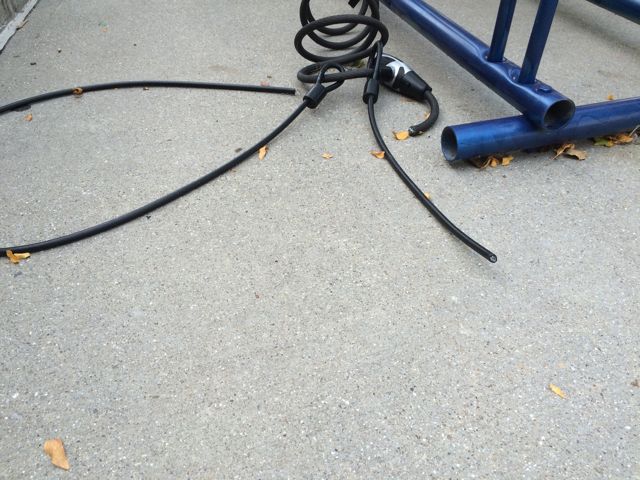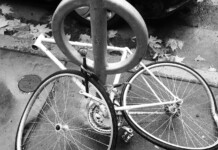
By Detective Lisa Pascadlo, Salt Lake City Police Department
With spring weather comes more ridership and an unfortunate and unwanted partner — theft. The old adage that you don’t know what you have until it’s gone holds just as true once your beloved means of transportation makes a disappearing act. While theft cannot always be prevented, you can improve your odds of not only keeping your bike, but also recovering it if the sticky fingers in your neighborhood happen to get lucky.
Go to any place cyclists congregate and you’ll hear conversations that to outsiders sound like a foreign language. Terms like “fixie,” “groupo” and “Cateye” will mean absolutely nothing unless you own a bike — and I guarantee you that any one of you, right now, can explain in minute detail every part of your bike, right down to the epic scrape on the top tube you got when trying to follow Crazy Eric down the Subway. The problem with this is that when your bike goes bye-bye, trying to articulate said detail so that it would be identifiable to a police officer on the street is problematic. Do the following and improve your odds significantly toward recovering your bicycle if it should be stolen.
Prevention:
• Document EVERYTHING! And I do mean everything, not just your serial number. This means the type and style of every component, factory or your own, that you have added to the bike. Save it on paper, parchment, or even a jump drive. Put this information in a safe place in your home in the event you need it later. Keep the list updated as you accessorize your ride.
• Take photos. Document with your camera everything you wrote down. Serial number, components, and most especially the location of damage. This is particularly important if your bike has been modified, updated or customized. Keep the photos and the written documentation together.
• Register and License your bike with your local municipality. This involves a small portion of your time and money, but it saves a lot of heartache later. Take your bike to your local police station (sometimes fire stations do this as well, check with your local jurisdiction) and register the bike. This will record your serial number and personal information that can be retrieved once a bike is taken or, on the other end, found. Without a serial number, your bicycle cannot be entered into a missing bikes database, nor could a search warrant be issued for internet sites should your stolen bike show up on them. I cannot tell you how many times I receive a call asking to check if a bike someone wants to buy is stolen. It may be, but I can’t be sure without a serial number entered in a database somewhere!
•Register your bike with Cycling West and Bike Index, (do this before it is stolen) upload photos, and the serial number too!
•Register your bike with your local police department. In Salt Lake City, see Salt Lake City Bicycle Registration.
•For more tips from Cycling West, see our Bike Theft Prevention page.
•Report your bike as stolen with Cycling Utah and Bike Index – If you haven’t registered your bike before, you can do so now and report it as stolen. If you have registered it, login and follow the instructions. Click here.
Lock your bike:
The next step to protect yourself is to consider where you leave your bike, but more importantly, how you leave your bike. Most of our bikes live in a house, some might live on a porch, some just live in a car. Wherever your bike lives, THE most important factor that makes or breaks you becoming a victim of theft is the type of lock.
• Buy the best lock you can afford. I will tell you that if you make it easy for a thief, you virtually guarantee becoming a victim. Cable locks are often specifically targeted by thieves because they are ridiculously easy to cut. Some of the U-locks with a circular key can be defeated, but take some time. The key here is to make it just difficult enough to make the thief think twice, and move on. I know some folks who use two locks for that exact reason. I use a set of handcuffs, because I figure that alone might give a thief reason to think long and hard about the consequences.
• Lock it up, even at home. You would be surprised how many home burglaries account for the total number of bike thefts in any city. Don’t assume that just because it is in your home that it won’t be stolen. One suggestion is to install a U-bolt to a wall stud, then use it like a locking ring. The only thing you lose is a tiny amount of time in your day, but at least you will still have your bike! This goes for leaving it on a deck, veranda or in an unsecured garage or shed.
• Pick your parking place carefully. Not every location has a bike rack. Not every location with a bike rack is necessarily a great place to leave your bike. The rule here is visibility. Is the location highly visible to passersby? Is the location a high-traffic area? A general rule to follow is that if it doesn’t feel good, it probably isn’t! Make sure that what you are locking your bicycle to is also solidly fixed, e.g., in the ground or to something else. Shake it before you lock to it, some thieves have gone so far as to modify popular racks — fences, signposts, and railings — so that they can undo a bolt or separate the metal and just walk away with the bike, lock and all.
What do you do if your bike is stolen?
Now say that you’ve done all you can do to protect yourself, but the unfortunate still happens and some thief makes off with your ride. Follow these steps to increase the odds of having your bike returned.
• File a theft report with the police department. This is dependent on where the bicycle was stolen from, not where you live. This is when you will need all that documentation. The sooner you can provide the detailed information on your bicycle to the police, the sooner it will be placed on the nationwide theft database (called NCIC). Gather your data, and make that call as soon as you can.
•Report your bike as stolen with Cycling Utah and Bike Index – If you haven’t registered your bike before, you can do so now and report it as stolen. If you have registered it, login and follow the instructions.
• Spread the word. There are usually social media sites or other networking avenues that are cycling specific. Post your stolen bike information! If you can have 200 other people aware that your bicycle is stolen, that’s 200 more sets of eyes watching out for it.
• Check the classifieds, old and new. Don’t just look for your bike, look for your components. High-end bikes can be parted out and sold in pieces. This is why it is so important to know the very specific details of every piece of your bike. Don’t forget the online classifieds, too.
• Look through websites and apps such as Offer Up, KSL.com, LetGo, Craigslist, Facebook Marketplace, and others to see if you can find your bike.
•Check the Stolen Bike Listings on Cycling Utah
•Check the stolen bike listings on Bike Index
• Check the pawnshops and secondhand dealers.
So what do you do if you find your bike in the classifieds?
• Notify the police. Call the same police department to which you reported the theft and ask for the detective assigned to your case. You will need your case number to save time. If it is on a weekend, ask to speak with an officer. Please understand that in order to obtain the contact information of the seller, law enforcement usually has to apply for a search warrant.
• Take a screenshot of the ad. This could be difficult if you are on a mobile device, but sometimes these ads are up for an hour, and then gone. It is helpful to the detective to have a copy of the ad, particularly if there is a photo of your bike on it, as ads are quickly pulled by these sellers. Once out of public view, law enforcement must apply for a search warrant to see it.
• To contact the seller or not? This is entirely up to you, and I don’t recommend it. Remember, the person you are calling is a thief. They may be just a thief or they may be supporting other criminal activity. Odds are, they’re the latter.
Some bicycles end up at pawnshops or secondhand dealers. These are unique situations that are not “victim-friendly.” In Utah, these businesses in particular are regulated to some extent. Whenever a person sells or pawns an item, the shop must record and enter the seller’s personal information into a database. If the item is sold to the shop, it is held in an area out of public view for 15 days, after which it may be placed into the merchandise area. If the item is pawned (meaning held as collateral for a cash advance), it must be held 30 days before which it may be sold.
To understand what happens when stolen property is pawned at a pawnshop, a little discussion of law is in order. In layman’s terms, when a bike is stolen the crime is theft and the victim is the bicycle owner (you). When the stolen bicycle is then pawned at a business, the crime is theft by receiving stolen property and/or possession of stolen property, and the victim is the pawnshop. The person pawning the item may not be the person who stole the bike, and it is up to law enforcement to determine who did. It can be very difficult to accumulate enough evidence to charge the actual thief, but fairly easy to charge the person pawning the property. Confusing, huh!
If you choose to look for your bicycle in these types of businesses, please be aware of the following:
• You can ask to see the held items, but expect to be denied. There is no expectation of cooperation with a victim, nor with law enforcement without a search warrant.
• If you do happen to find your bike, notify the shop manager and call the police department to whom you reported the theft.
• The only certain way you will be able to get your bike back when you find it is to pay for it. You will not be paying what the shop paid; you will be paying what the shop would sell it for! If you do so, you are eliminating the pawnshop as a victim. You still need to notify not only the agency to whom you reported the theft, but the police department in whose jurisdiction the shop does business.
• If you choose not to pay for your bicycle, you still need to notify both police agencies. Since the pawnshop is also a victim, the bicycle is held as evidence until a conviction is gained, at which time restitution will be paid to the pawnshop and you get your bike. This process is not speedy, nor is it guaranteed.
Following these steps will serve not only you by making it more likely that you remain in possession of your bike, but also the community as a whole by making bike theft less appealing.
Note: In the 2012 Utah Legislative session, a modification to the pawnshop law was proposed that would have eliminated the requirement that a victim pay for their own property. It did not pass, unfortunately.







What should I do with a bike that was found, or rather left, in our front yard? It just showed up one morning and sat there all day. We asked neighbors if they knew to whom it belonged with no luck.
You should call your local police department and turn it in to them. They will hold it for a specified amount of time (90 – 180 days?) and try and return it to the owner. If the bike is unclaimed, then depending on the police department, you may get to keep it, it may get donated to charity (often the Bicycle Collective), or sold at auction.
[…] https://www.cyclingwest.com/tech/uh-oh-whered-my-bike-go-2/ […]
How to check if a bike is stolen when you want to resort to second-hand bikes to cut costs, while not compromising bike quality. First, you should: Read and inspect the seller’s information. The seller’s information is the number one factor in knowing whether you are dealing with a stolen bike. Another way to determine a stolen bike is through a bike serial number check is usually found on the bicycle’s bottom, below the pedals, and bottom bracket or if you are highly suspicious of the seller, check the bike if it underwent repainting.
Cheaper prices do not always mean the best deal. In some instances, purchasing a bike at a very low price is a red flag to raise suspicion. With the ever-increasing trend of selling products online, there is also an increase in different ways scammers can get potential victims.
Comments are closed.